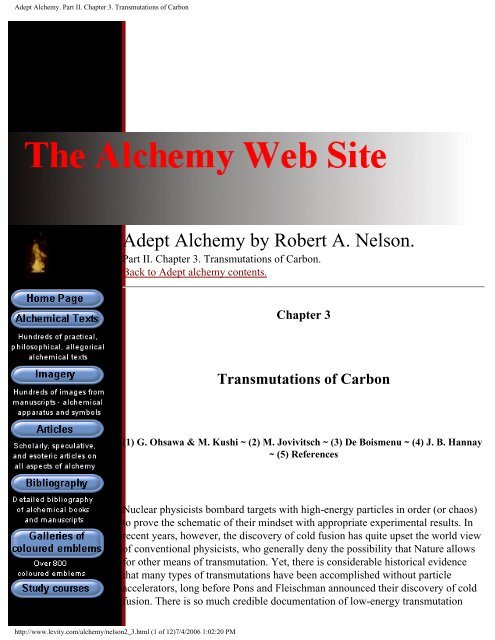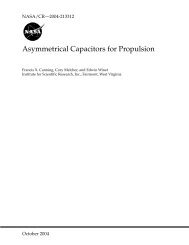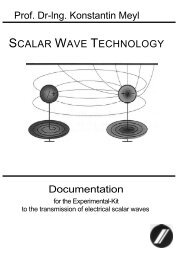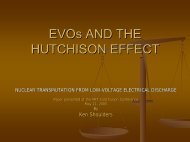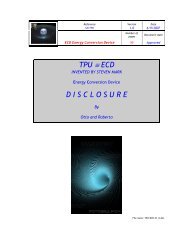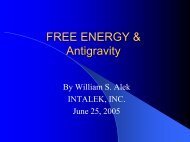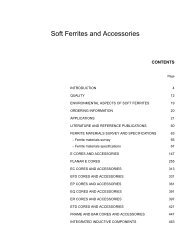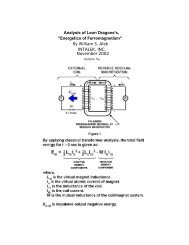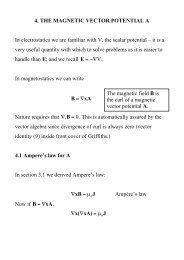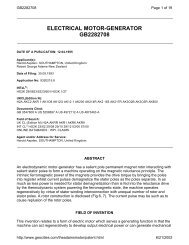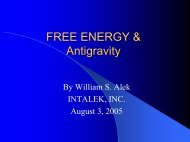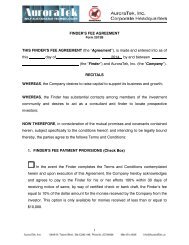The Transmutations of Carbon
The Transmutations of Carbon
The Transmutations of Carbon
You also want an ePaper? Increase the reach of your titles
YUMPU automatically turns print PDFs into web optimized ePapers that Google loves.
Adept Alchemy. Part II. Chapter 3. <strong>Transmutations</strong> <strong>of</strong> <strong>Carbon</strong>Adept Alchemy by Robert A. Nelson.Part II. Chapter 3. <strong>Transmutations</strong> <strong>of</strong> <strong>Carbon</strong>.Back to Adept alchemy contents.Chapter 3<strong>Transmutations</strong> <strong>of</strong> <strong>Carbon</strong>(1) G. Ohsawa & M. Kushi ~ (2) M. Jovivitsch ~ (3) De Boismenu ~ (4) J. B. Hannay~ (5) ReferencesNuclear physicists bombard targets with high-energy particles in order (or chaos)to prove the schematic <strong>of</strong> their mindset with appropriate experimental results. Inrecent years, however, the discovery <strong>of</strong> cold fusion has quite upset the world view<strong>of</strong> conventional physicists, who generally deny the possibility that Nature allowsfor other means <strong>of</strong> transmutation. Yet, there is considerable historical evidencethat many types <strong>of</strong> transmutations have been accomplished without particleaccelerators, long before Pons and Fleischman announced their discovery <strong>of</strong> coldfusion. <strong>The</strong>re is so much credible documentation <strong>of</strong> low-energy transmutationhttp://www.levity.com/alchemy/nelson2_3.html (1 <strong>of</strong> 12)7/4/2006 1:02:20 PM
Adept Alchemy. Part II. Chapter 3. <strong>Transmutations</strong> <strong>of</strong> <strong>Carbon</strong>that, in the words <strong>of</strong> Rupert Gould, "did it relate to any more probable event, weshould be compelled either to accept it or cease putting any faith in recordedtestimony."Among the many examples that can be cited, "biological transmutation" is thebest developed and well-known. About forty years ago, Dr. Louis Kervranpresented the idea that sodium, potassium, and dozens <strong>of</strong> other elements changeinto each other under certain natural conditions in the mineral, vegetable, andanimal kingdoms. Biological transmutations have been demonstrated, crucialexperiments replicated, and the theoretical principles verified by many scientistswho are finding new industrial, medical and agricultural applications <strong>of</strong> thediscoveries.(1) G. Ohsawa & M. KushiInspired by the pioneering work <strong>of</strong> Dr. Kervran, Dr. George Ohsawa sought totransmute sodium into potassium in vitro. <strong>The</strong> method revealed itself to him in asymbolic dream. Thus inspired, Dr. Ohsawa and Michio Kushi, et al., constructedan experimental electric discharge tube with copper (Yin) and iron (Yang)electrodes and a valve through which to draw a vacuum or admit oxygen (Fig.3.1). <strong>The</strong> first transmutation with this equipment was achieved on June 21, 1964.After applying 60 watts <strong>of</strong> electricity for 30 minutes to heat sodium to a plasma, amolar equivalent <strong>of</strong> oxygen was introduced. Viewed with a spectroscope, theorange band <strong>of</strong> sodium gave way to the blue <strong>of</strong> potassium, according to theformula:Na 23 + O 16 = K 39Analysis <strong>of</strong> the reaction product confirmed the result and revealed an unexpectedextra: a trace <strong>of</strong> gold was produced by the combination <strong>of</strong> Na, O, and K with theCu and Fe electrodes. Several different metals were tested as electrode materials.Neon and argon atmospheres were found to enhance the yield <strong>of</strong> potassium andother elements. External heating <strong>of</strong> the reaction tube also served to ionize thesodium.Dr. Louis Kervran noted these experiments in his book <strong>Transmutations</strong> A FaibleEnergie:Pr<strong>of</strong>essor [Masashiro] Torii, on a circuit designed by Pr<strong>of</strong>. Sakurazawa,and under the control <strong>of</strong> Pr<strong>of</strong>. Odagiri, observed in the spectroscope thepassage <strong>of</strong> sodium to potassium upon the adjunction <strong>of</strong> a small quantity <strong>of</strong>oxygen to sodium vapor...Pr<strong>of</strong>. Torii [<strong>of</strong> Musashino Institute <strong>of</strong> Technology, Tokyo] has informedhttp://www.levity.com/alchemy/nelson2_3.html (2 <strong>of</strong> 12)7/4/2006 1:02:20 PM
Adept Alchemy. Part II. Chapter 3. <strong>Transmutations</strong> <strong>of</strong> <strong>Carbon</strong>me <strong>of</strong> having observed on 21 June 1963, in the spectroscope, the passage<strong>of</strong> sodium to potassium, the disappearance <strong>of</strong> the yellow line <strong>of</strong> sodiumbeing replaced by the red-violet ray <strong>of</strong> 7699 A o potassium; the experimentwas repeated June 22 before five scientists...In the production <strong>of</strong> steel in electric furnaces, the incomprehensibleappearance <strong>of</strong> boron [has been observed]. We see now that we cannotexclude, under the effect <strong>of</strong> a powerful electric field and <strong>of</strong> the hightemperature <strong>of</strong> these furnaces, the 'reduction' <strong>of</strong> carbon from the loss <strong>of</strong>hydrogen and in keeping with: C - H = B...<strong>The</strong> experience is simple to realize, as it suffices to take a plate <strong>of</strong> steel ---or <strong>of</strong> iron ⎯ an anode <strong>of</strong> magnesium, place them in a jar containingdistilled water rendered conductive by a salt <strong>of</strong> magnesium ⎯ in order notto introduce any metallic ion other than magnesium, and these twoelectrodes are reunited by a metal wire, to the exterior <strong>of</strong> the jar; thus theyrealize (in part) a battery with magnesium at the negative, iron as positive;through the production <strong>of</strong> hydrogen at the electrode, magnesium is at apotential <strong>of</strong> 1.9 volts more negative than iron. Leave it for two or threemonths; from time to time add a little distilled water in order tocompensate for evaporation. On analysis, calcium is obtained... in anoperation in which calcium was not introduced!<strong>The</strong> calcium (as oxide) accumulates in scales on the cathode.Kushi and Ohsawa, et al., proceeded to develop their process for industrial-scaleproduction. <strong>The</strong>y estimated that potassium could be manufactured for 1% <strong>of</strong> thecurrent price. In a correspondence to Ken Jones (12 October 1980), Michio Kushistated:After George Ohsawa and myself succeeded in producing K out <strong>of</strong> Na andO... we presented the experiment to several chemical corporations. At thattime, Pfizer International became most actively interested. We hadconferences on several occasions; however, soon after we decided not tobecome involved with these corporations, as a result <strong>of</strong> the considerations<strong>of</strong> the vast effects this would have on the industry.<strong>The</strong> researchers also had no patent with which to protect their interests. Ohsawaand Kushi then turned their attention to the manufacture <strong>of</strong> steel by transmutation<strong>of</strong> carbon and oxygen according to the formula:2 (C 12 + O 16 ) = 2 Si 28 = Ni 56 = Fe 56http://www.levity.com/alchemy/nelson2_3.html (3 <strong>of</strong> 12)7/4/2006 1:02:20 PM
Adept Alchemy. Part II. Chapter 3. <strong>Transmutations</strong> <strong>of</strong> <strong>Carbon</strong><strong>The</strong> experimental arrangements worked as predicted, and produced several otherelements from combinations <strong>of</strong> C and O with atmospheric nitrogen, etc:<strong>The</strong> Fe produced by this transmutation is stainless; it does not rust easily.Also it reacts much less to heat than does ordinary Fe... All results <strong>of</strong> thetransmutation for Fe have been carefully examined and analyzed byseveral methods, as: (1) magnetic inspection, (2) spectroscopic analysis,(3) chemical analysis, (4) examination by reagents, etc, and confirmed byauthoritative testing agencies.<strong>The</strong> new form <strong>of</strong> iron was called GOS (George Ohsawa Steel). <strong>The</strong> experimentalmethod is as follows:Method 1: Transmutation in Air [Fig. 3.2] ⎯ Two graphite crucibles(approx 2.5" x 5") cover each other top and bottom. <strong>The</strong> upper crucible hasa 10 mm Hole, surrounded by a ceramic ring, which acts as an insulator.Into this hole a carbon rod (0.25" diam) is inserted until it reaches the 2 or3 grams <strong>of</strong> carbon powder placed at the bottom <strong>of</strong> the lower crucible,which has one or two small holes at the lower part <strong>of</strong> its side wall forcirculation <strong>of</strong> air. An iron base placed under the lower crucible acts asanother electric pole. As the carbon rod approaches the powder, theelectric arc arises. Continuing the operation for 20 to 30 minutes, thecarbon powder changes to iron. In this experiment, the applied electricityis about 35 to 50 volts/8 to 18 amps, either AC or DC.Method 2: Transmutation in Water ⎯ Using two carbon rods (0.25"diam.), create an electric arc between them, striking them on one anotherin water. This operation is performed for 1 to 5 seconds. <strong>The</strong>n, brownblackmetallic powder (which contains iron) falls down to the bottom <strong>of</strong>the water.Method 3: Transmutation in Air ⎯ <strong>Carbon</strong> powder is placed on a copperplate, approximately 12" long, 6" wide, and 0.5" thick. This plate works asan electrical ground. A carbon rod (0.25" diam.) used as the otherelectrical pole, is struck repeatedly to the carbon powder on the plate,producing an electric arc. <strong>The</strong> carbon powder changes into iron.During the process <strong>of</strong> this transmutation, nickel is temporarily produced asa short-lived radioactive isotope. <strong>The</strong> degree <strong>of</strong> transmutation from C andO is approximately 5% to 20% immediately, with a larger percent <strong>of</strong>transmutation occurring gradually in the air, which has the effect <strong>of</strong>cooling the metallic powder to below room temperature.In another experimental configuration (Fig. 3.3), the reaction was cooled by dryhttp://www.levity.com/alchemy/nelson2_3.html (4 <strong>of</strong> 12)7/4/2006 1:02:20 PM
Adept Alchemy. Part II. Chapter 3. <strong>Transmutations</strong> <strong>of</strong> <strong>Carbon</strong>ice. When sparked with carbon rods, the CO 2 vapors also yielded iron, etc..In 1994, R. Sundaresan and J.Bockris (Texas A&M) reported that they hadobserved "Anomalous Reactions During Arcing Between <strong>Carbon</strong> Rods In Water:Spectroscopically pure carbon rods were subjected to a carbon arc inhighly purified water. <strong>The</strong> arc current varied from 20 to 25 A and waspassed intermittently for several hours. <strong>The</strong> original carbon contained ~ 2ppm Fe. <strong>The</strong> C rods remained cool to the touch at >2 cm from their tips.Adsorption <strong>of</strong> iron from water or the surrounding atmosphere wasestablished as not being the cause <strong>of</strong> the increase <strong>of</strong> iron. <strong>The</strong>re is a weakcorrelation between the iron formed and the time <strong>of</strong> passage <strong>of</strong> current.When dissolved O 2 was replaced by N 2 in the solution, no iron wasformed. Hence, the mechanism2 6 C 12 + 2 8 O 18 ⇒ 26 Fe 56 + 2 He 4was suggested as the origin <strong>of</strong> the iron. <strong>The</strong> increase in temperature <strong>of</strong> thesolution was consistent with expectation based on this reaction.Also in 1994, another group <strong>of</strong> researchers (M. Singh, et al.) at the BhabhaAtomic Research Centre (Bombay) reported their "Verification <strong>of</strong> the G. OhsawaExperiment for Anomalous Production <strong>of</strong> Iron from <strong>Carbon</strong> Arc in Water:A direct current arc was run between ultrapure graphite electrodes dippedin ultrapure water for 1-20 hours. <strong>The</strong> graphite residue collected at thebottom <strong>of</strong> the water trough was analyzed for Fe content by a conventionalspectrographic method... <strong>The</strong> Fe content was fairly high, depending on theduration <strong>of</strong> the arcing... <strong>The</strong> results showed large variations in Fe content(50 to 2000 ppm) in the C residue. In the second series <strong>of</strong> experiments...with the water trough fully covered, the amount <strong>of</strong> Fe in the carbon residuedecreased significantly (20-100 ppm). Here also there were largevariations in the iron concentration in the residue, although theexperiments were performed under identical conditions. Whether Fe isreally being synthesized through transmutation from C and O as suggestedby George Ohsawa or is getting concentrated to different degrees throughsome other phenomenon is not currently clear. <strong>The</strong> Fe in the C residue wasalso analyzed by mass spectroscopy for the abundance <strong>of</strong> variousisotopes... Besides Fe, the presence <strong>of</strong> other elements like Si, Ni, Al, andCr was also determined in the C residue, and it was found that thevariation <strong>of</strong> their concentrations followed the same pattern as that <strong>of</strong> Fe.http://www.levity.com/alchemy/nelson2_3.html (5 <strong>of</strong> 12)7/4/2006 1:02:20 PM
Adept Alchemy. Part II. Chapter 3. <strong>Transmutations</strong> <strong>of</strong> <strong>Carbon</strong>In 1996, Kenjin Sasaki reported his successful experimental replication <strong>of</strong> thecarbon arc production <strong>of</strong> iron. He used a 99.9999% pure graphite crucible and rodwith a 100V/10A electric welder. <strong>The</strong> crucible was cooled. <strong>The</strong> arc (8-10A)struck high-purity carbon powder 4 times for 1 minute each time. <strong>The</strong> yield <strong>of</strong>iron was recovered with a magnet. Further experiments conducted by C. Akbar(Kushi Research Institute) "indicate that voltage potential and current density areimportant in the formation <strong>of</strong> iron in chemically pure carbon."Toby Grotz also conducted this experiment and reported the results in detail in1996. He tested activated charcoal, activated carbon, and coal. No iron wasproduced from charcoal, but activated carbon did yield magnetic material. Testswere performed with copper and aluminum plates and rods to eliminate thepossibility that the carbon rod and copper plate might be releasing iron:This amount [0.22 gr] <strong>of</strong> iron is an order <strong>of</strong> magnitude less than that whichoccurs naturally in the sample... <strong>The</strong> excess weight appears to be due tomagnetic material that is part <strong>of</strong> or encased in particles <strong>of</strong> carbon... <strong>The</strong>reis a point at which no more magnetic material may be removed from thesample using the arc discharge process. It is proposed here that the highcurrent density <strong>of</strong> the arc discharge magnetizes magnetic material thatexists within the particles <strong>of</strong> the activated carbon. This then allowsseparation <strong>of</strong> the magnetic material from the sample using a magnet...J. Bockris and associates replicated the experiment using the underwater arcingmethod, and found only microgram amounts <strong>of</strong> iron after 24 hours. When theexperiment was repeated with the reaction vessel covered to exclude air, no ironwas found.Those results suggest that at least some <strong>of</strong> the reported yields <strong>of</strong> iron might be dueto the arc coagulating ORMEs (Orbitally Rearranged Monoatomic Elements)existing in the Earth's atmosphere. ORMEs are virtually undetectable by allconventional methods except infrared analysis, which can distinguish a certaincharacteristic doublet. As David Hudson discovered in the 1980s, ORMEs can beconverted to metallic form by certain processes involving carbon or nitrogen,which are used to insert an electron in the d orbital shell <strong>of</strong> the atoms. <strong>The</strong>complete process is described in his Australian patent.Dr. Joseph McKibben has published his suggestion that the transmutativeproduction <strong>of</strong> iron from carbon may be due to what he calls a subquark particle,which has a mass <strong>of</strong> about 1.15 nucleons:<strong>The</strong> subquark, when attached the 4 He seemed to me to be an idealcandidate for an ideal catalytic agent.http://www.levity.com/alchemy/nelson2_3.html (6 <strong>of</strong> 12)7/4/2006 1:02:20 PM
Adept Alchemy. Part II. Chapter 3. <strong>Transmutations</strong> <strong>of</strong> <strong>Carbon</strong>In the 1980s, Michio Kushi resumed his experiments with the "aim <strong>of</strong> findingmethods <strong>of</strong> mass production":At that time I shall be able to consider how to present to the world thetransmutation <strong>of</strong> the atom using the principles <strong>of</strong> Yin and Yang for thefuture world industry.<strong>The</strong> transmutation <strong>of</strong> the atom can be achieved if elements are changedinto the state <strong>of</strong> plasma, and if these elements are well understood in theirantagonistic and complementary relations to other elements, according tothe principles <strong>of</strong> Yin and Yang.<strong>The</strong> atomic number, mass, density, and gravity, physical reaction totemperature such as melting and boiling points, chemical reactions to otherelements, reactions to specific environmental factors, such as ultravioletand infrared wavelengths applied to the elements, as well as spectroscopiccolor analysis ⎯ all <strong>of</strong> these characteristics <strong>of</strong> the atom can contribute toclassify the atom into the Yin group or Yang group...Nothing is solely Yin or Yang: everything involves polarity. <strong>The</strong>re isnothing neuter. Either Yin or Yang is in excess in every occurrence. LargeYin attracts small Yin; larger Yang attracts small Yang. At extremes, Yinproduces Yang, and Yang produces Yin. All physical forms and objectsare Yang at the center and Yin at the surface."Hydrogen, the center <strong>of</strong> the atomic spiral, is Yang. It gathers particles toitself, forming the first octave <strong>of</strong> creation. <strong>The</strong> conditions become apparentupon studying the melting and boiling points <strong>of</strong> the first eight elements.Within the first octave, the greatest attraction is between carbon andoxygen, which represent Yin and Yang respectively. It is the fugateinteraction <strong>of</strong> these two that form the other elements. <strong>Carbon</strong> is <strong>of</strong>tenreplaced by boron. In terms <strong>of</strong> Yin and Yang, these are like brothers in thatthey react in similar ways in forming new elements.Since the initial experiments were conducted by George Ohsawa and MichioKushi in the 1970s, several other researchers have reported the same results andmore, thanks to modern analytical equipment, computers, and communication.<strong>The</strong> worlds <strong>of</strong> low-energy transmutations have become much more accessible tous. New discoveries are being reported at an increasing rate in the scientificliterature, particularly cold fusion and biological transmutations. Perhaps within afew decades we shall see the mass production <strong>of</strong> elements on demand. (1, 7, 10-18,22, 23)http://www.levity.com/alchemy/nelson2_3.html (7 <strong>of</strong> 12)7/4/2006 1:02:20 PM
Adept Alchemy. Part II. Chapter 3. <strong>Transmutations</strong> <strong>of</strong> <strong>Carbon</strong>------------------------------------------------------------------------------------------------------------<strong>The</strong> Fugate <strong>of</strong> <strong>Carbon</strong>1 (C + O) = Si 5 (C + O) = Ce2 (C + O) = Fe 6 (C + O) = Er3 (C + O) = Kr 7 (C + O) = Pt4 (C + O) = Cd After Pt the elements become increasingly Yin-------------------------------------------------------------------------------------------Classification: Yin YangTendency: Expansion ContractionPosition: Outward InwardStructure: Space TimeColor: Purple RedTemperature: Cold HotWeight: Light HeavyCatalyst: Water FireAtomic: Electron ProtonElements: K, O, P, Ca, N, etc. H, As, Cl, Na, C, etc.---------------------------------------------------------------------------------------------------(2) M. Jovivitsch: <strong>Carbon</strong> to OxygenIn 1908, Milorad Z. Jovivitsch (Bergau-Akademie in Belgrad) published twounique articles in the journal Monatschrift fur Chemie, describing "<strong>The</strong>Mysterious Deficiency <strong>of</strong> <strong>Carbon</strong> in the Condensation Products from Ethyleneand Acetylene."Jovivitsch had been experimenting with electrical discharges in these gases,following the methods used by Berthelot. <strong>The</strong> latter had shown that the action <strong>of</strong> asilent electric discharge upon saturated or unsaturated hydrocarbons will split <strong>of</strong>fhydrogen and produce condensation products. (4, 6, 12)http://www.levity.com/alchemy/nelson2_3.html (8 <strong>of</strong> 12)7/4/2006 1:02:20 PM
Adept Alchemy. Part II. Chapter 3. <strong>Transmutations</strong> <strong>of</strong> <strong>Carbon</strong>Jovivitsch introduced pure dry ethylene or acetylene and oxygen into an ozonizercontaining copper oxide, and electrified the mixture with 100 volts/3 amps for 3days and 2 nights. His analysis <strong>of</strong> the resulting compounds showed a deficiency inthe theoretical amount <strong>of</strong> carbon and hydrogen, and an excess <strong>of</strong> oxygen. Severaldeterminations <strong>of</strong> the carbon and hydrogen taken together indicated a 7%deficiency in the ethylene reaction product, and a 22% deficiency in the case <strong>of</strong>acetylene.Berthelot had accounted for these losses by attributing them to oxygen absorptionfrom the atmosphere. Jovivitsch excluded that possibility by employing puregases, and he immediately preserved the products in hermetically sealed tubes.<strong>The</strong>re was practically no possibility <strong>of</strong> absorbing any significant amount <strong>of</strong>atmospheric oxygen. He also determined that the condensed ethylene loses nocarbon on exposure to air, and that the condensed acetylene remains unchangedafter many weeks. Comparative analysis <strong>of</strong> the reaction products preserved intubes and those exposed to air showed them to be in close agreement.Jovivitsch attempted to explain the scientific riddle <strong>of</strong> this chemical anomaly byattributing it either to experimental error or the transformation <strong>of</strong> elements.Because he took great care and made very precise analyses, Jovivitsch wasconvinced that a transmutation had occurred. His opinion was reinforced by thefact that the condensation products were radioactive.(3) E. De Boismenu: DiamondsIn 1913, the French engineer M.E. De Boismenu, the director <strong>of</strong> an electriccarbide furnace plant in Paris, announced the issuance <strong>of</strong> his patent for a veryeasy new method to produce artificial diamonds in an electric furnace. <strong>The</strong> largestspecimens produced at that time was 2-1/2 millimeters in diameter; it was "cutwith 32 facets with remarkable dexterity."<strong>The</strong> furnace was built <strong>of</strong> refractory brick and had two carbon electrodes (6-1/2"diam.), one <strong>of</strong> which could be adjusted manually. <strong>The</strong> bed was packed with amixture <strong>of</strong> powdered lime and carbon; this was found to be the best way tosupport a trough, made <strong>of</strong> fused calcium carbide (CaC), in which the carbonelectrodes operated. <strong>The</strong> trough was filled with 8 lb <strong>of</strong> CaC fragments and melted(34 V/800 A /6 hr). More CaC was piled on the trough, and the whole wascovered with more <strong>of</strong> the lime-carbon mixture, and finally with refractory bricks.<strong>The</strong> furnace was run for another 12 hours. <strong>The</strong> negative pole became coveredwith a black carbonaceous deposit weighing about 700 gr. <strong>The</strong> mass was soakedin water and the diamonds were picked out; their size varied from 1/2 to 2-1/2mm diameter. <strong>The</strong> last reported run <strong>of</strong> the furnace (12 hr @ 700-800 A/24-25 V)produced over a dozen diamonds, some as large as 1/10 inch diameter. <strong>The</strong>y werehttp://www.levity.com/alchemy/nelson2_3.html (9 <strong>of</strong> 12)7/4/2006 1:02:20 PM
Adept Alchemy. Part II. Chapter 3. <strong>Transmutations</strong> <strong>of</strong> <strong>Carbon</strong>indistinguishable from natural diamonds. (21)A similar method was developed by Felix Sebba, a chemical engineer at theVirginia Polytechnic Institute & State University (Blacksburg, VA). He improvedon the technique developed by Charles V. Burton in 1905 (C dissolved in moltenPb-Ca, then cooled). Sebba dissolved calcium carbide in molten lead. Steam at550 o C was passed over the melt and reacted with the Ca (but not the Pb),forming calcium hydroxide which forms a slag on the surface. Some <strong>of</strong> the carboncrystallizes as diamonds. Although these methods are not transmutations, they aremost interesting allotropisms. (5, 19)Lea Potts was featured in Life magazine (March 1993) for his production <strong>of</strong>diamonds with a blowtorch.(4) J. B. HannayIn 1880, J.B. Hannay <strong>of</strong> Glasgow made diamonds from Dippel's Oil, catalyzed bylithium metal in thick iron tubes at red heat. <strong>The</strong> minute yield (14 mg) <strong>of</strong> Type Bblue diamonds exhibited all the characteristics and properties <strong>of</strong> naturaldiamonds. Hannay was attempting to produce nascent carbon. He found thatwhen carbon is liberated from a nitrogenous hydrocarbon in the presence <strong>of</strong> Li,Na, Mg or K at red heat and high pressure, the metal hydride is formed, and thecarbon reacts with (or is stabilized by) the nitrogen and assumes diamond form.No diamonds were found in experiments without N. (8, 9)Dippel's Oil is a nitrogenous by-product <strong>of</strong> the dry distillation manufacture <strong>of</strong>bone char. <strong>The</strong> principal N-ingredient is pyridine. <strong>The</strong> iron tubes were 20" x 4" o.d. x 1/2" i.d.. Most <strong>of</strong> them ruptured during the experiments.<strong>The</strong> largest yield was obtained from a mixture <strong>of</strong> "paraffin spirit boiling at 75 o [amixture <strong>of</strong> light paraffins], 90%, together with 10% <strong>of</strong> carefully rectified bone-oil[Dippel's Oil, bp 115-150 o ]; these were placed with metallic Li (4 gr) in an irontube" (20" x 4" o.d. x 1/2" i.d.) which was heated to redness for 14 hours. <strong>The</strong>tubes usually exploded, or the vapors escaped through the porous iron, orcombined with it. Only 4 experiments (out <strong>of</strong> 34) were successful.In his Bakerian Lecture for 1918, Sir Charles Parsons reported that he hadrepeated Hannay's experiments without success. He doubted that Hannay hadmade genuine diamonds. Bannister and Lonsdale, however, obtained samples <strong>of</strong>Hannay's diamonds from the British Museum; X-ray analysis showed they aregenuine. (2, 3, 20)Hannay's approach to diamonds is interesting, but it is not feasible for industrialhttp://www.levity.com/alchemy/nelson2_3.html (10 <strong>of</strong> 12)7/4/2006 1:02:20 PM
Adept Alchemy. Part II. Chapter 3. <strong>Transmutations</strong> <strong>of</strong> <strong>Carbon</strong>application. Several other methods <strong>of</strong> manufacturing diamonds have beendeveloped since then, but none are so simple as the technique developed by DeBoismenu.(5) References1. Anonymous: <strong>The</strong> Order <strong>of</strong> the Universe 3 (10): 12, 14-17.2. Bannister, F.A., & Lonsdale, K.: Nature 151 (#3829): 334-335 (20 March 1943);"Lab. Synth..."3. Bannister, F.A., & Lonsdale, K.: Mineralogical Mag. 26: 315-325 (1941-43); "An X-Ray Study..."4. Berthelot: Ber. d. Deutschen Ges. 15: 988 (1882).5. Burton, Charles V.: Nature 72 (#1869): 1 (24 August 1905); "Artificial Diamonds"6. Chemical Abstracts 2 (1): 1410 (20 May 1908).7. Gardiner, Bruce: East-West Journal (February 1975), p. 15.8. Hannay, J.B.: Proc. Royal Soc. London 30: 461 (1880); ibid., 32: 407 (1881)9. Hannay, J.B.: Chemical News 86: 173 (1902)10. Grotz, T.: Fulcrum 4 (3):6-10 (Oct., 1996).11. Harris, P.M.: Unpublished lab notes (March 1965).12. Jovivitsch, Milorad Z.: Monatschrift f. Chemie 29: 1-4, 5-14 (1908).13. Kervran, Louis: <strong>Transmutations</strong> A Faible Energie; 1964, Libr. Maloine, Paris; ibid.,Preuves Relatives A l'Existence de <strong>Transmutations</strong> Biologiques (1968); ibid.,<strong>Transmutations</strong> Biologiques en Agronomie (1970); ibid., Biological <strong>Transmutations</strong>;1972, Swan House, NY, &c...14. Kushi, Michio: East-West Journal (February 1975), pp. 22-26.15. Kushi, Michio: Kushi Institute Study Guide # 10: "Atomic Transmutation".16. Mallove, E.: Infinite Energy , March-April 1996 (#7).17. McKibben, Joseph L.: Infinite Energy #11 (Nov.-Dec. 1996), p. 37http://www.levity.com/alchemy/nelson2_3.html (11 <strong>of</strong> 12)7/4/2006 1:02:20 PM
Adept Alchemy. Part II. Chapter 3. <strong>Transmutations</strong> <strong>of</strong> <strong>Carbon</strong>18. Ohmori, T. & Enyo, M.: J. New Energy 1(1):15-22 (1996).19. Peterson, Ivars: Nature (3 August 1985), p. 75; "Diamonds in Nature"20. Parsons, Sir Charles A.: Proc. Royal Soc. London 220-A: 67--93 (1918)21. Scientific American (7 June 1913), p. 515; "A New Way <strong>of</strong> Making Diamonds"22. Singh, M., et al.: Fusion Technology 26: 266 (Nov., 1994).23. Sundaresan, R. & Bockris, J.: Fusion Technology 26: 261 (Nov., 1994).****http://www.levity.com/alchemy/nelson2_3.html (12 <strong>of</strong> 12)7/4/2006 1:02:20 PM


